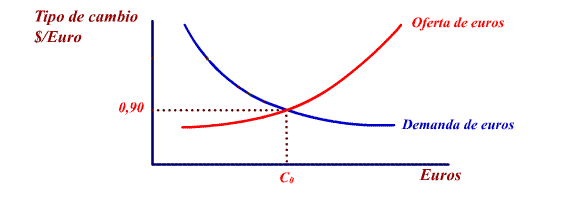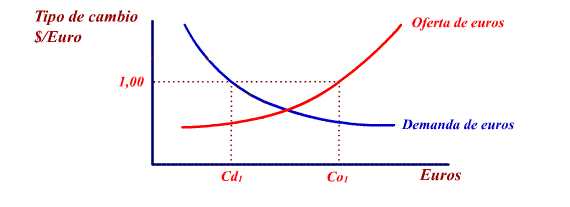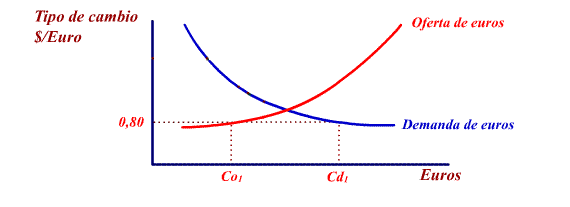Exchange Rates
The exchange rate specifies how much one currency
is worth in terms of another (the price at which it buys and sells).
The exchange rate is determined by the foreign exchange market:
¿Who buys
currency (and therefore sells a country's currency)?:
tourists that travel abroad, importers that have to buy abroad,
investors that want to finance a project in another country,
people that want to buy shares in foreign companies, speculators
that consider a currency to be cheap and who believe that with
time they will be able to sell the currency for more money,
etc.
¿Who buys
the national currency (and therefore sells currency)?:
foreign tourists that come to visit a country, exporters that
sold goods and have been paid in currency, foreign investors
that want to start up a project in the country or want to adquire
shares in a national company, speculators that consider the
national currency to be cheap and who believe they can sell
it at a later date at a higher price, etc.
The curve that represents the demand of currency
has a negative gradient with respect to the exchange rate: the
lower it is, the lower the currency and the more demand there
is for it.
Whilst the curve that respresents the currency
offer has a positive gradient: the higher the exchange rate, the
more expensive the currency and therefore those that have the
currency want to sell it.
The balanced exchange rate is
determined by the cut off point of these two curves.
If the exchange rate between the $ and the € is
0.90 this means that with every euro you spend you can buy
0.90 dollars.

What happens if the market is not
in balance?
Let's suppose that the point of
balance is $/€ 0,90 but the exchange rate which the Central
Bank applies is 1$/€. In this case the euro will be expensive
(with one euro you can buy one dollar when in balance you can
only buy 0.90 dollars).
With the euro being so expensive
exporting goods out of Europe will be difficult (goods will
seem expensive to other countries) and countries will favour
imports from different countries (as they will work out cheaper),
the amount of tourists going to Europe will decrease, some investment
projects in Europe will be rejected, etc. In short, the demand
for euros will decrease: this will cause the euro to start loosing
its value until it reaches the balance point.

Let's now suppose that the exchange
rate applied is 0.8$/euro.
In this case the euro is cheap, which
means that exporting will be easy and importing will be difficult,
tourism will increase and foreign investments will increase.
In short, the demand for euros will increase (and this will
weaken the dollar), which will make its value appreciate until
it again reaches the balance point.


